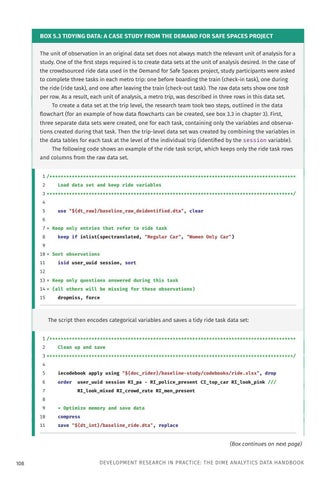BOX 5.3 TIDYING DATA: A CASE STUDY FROM THE DEMAND FOR SAFE SPACES PROJECT The unit of observation in an original data set does not always match the relevant unit of analysis for a study. One of the first steps required is to create data sets at the unit of analysis desired. In the case of the crowdsourced ride data used in the Demand for Safe Spaces project, study participants were asked to complete three tasks in each metro trip: one before boarding the train (check-in task), one during the ride (ride task), and one after leaving the train (check-out task). The raw data sets show one task per row. As a result, each unit of analysis, a metro trip, was described in three rows in this data set. To create a data set at the trip level, the research team took two steps, outlined in the data flowchart (for an example of how data flowcharts can be created, see box 3.3 in chapter 3). First, three separate data sets were created, one for each task, containing only the variables and observations created during that task. Then the trip-level data set was created by combining the variables in the data tables for each task at the level of the individual trip (identified by the session variable).
The following code shows an example of the ride task script, which keeps only the ride task rows
and columns from the raw data set. 1 /**************************************************************************************** 2
Load data set and keep ride variables
3 ****************************************************************************************/ 4 5
use "${dt_raw}/baseline_raw_deidentified.dta", clear
6 7 * Keep only entries that refer to ride task 8
keep if inlist(spectranslated, "Regular Car", "Women Only Car")
9 10 * Sort observations 11
isid user_uuid session, sort
12 13 * Keep only questions answered during this task 14 * (all others will be missing for these observations) 15
dropmiss, force
The script then encodes categorical variables and saves a tidy ride task data set: 1 /**************************************************************************************** 2
Clean up and save
3 ****************************************************************************************/ 4 5
iecodebook apply using "${doc_rider}/baseline-study/codebooks/ride.xlsx", drop
6
order
7
user_uuid session RI_pa - RI_police_present CI_top_car RI_look_pink /// RI_look_mixed RI_crowd_rate RI_men_present
8 9
* Optimize memory and save data
10
compress
11
save "${dt_int}/baseline_ride.dta", replace
(Box continues on next page) 108
DEVELOPMENT RESEARCH IN PRACTICE: THE DIME ANALYTICS DATA HANDBOOK





